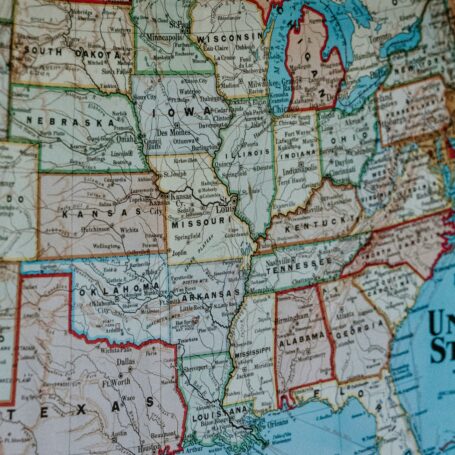The Mash of Cultures: Integration and Mixedness
The ‘clash of cultures’ is such a prominent meme in Western narrative these days that it tends to drown out an older (and probably more useful) meme, what we might call ‘the mash of cultures,’ in which disparate cultures sharing the same geography intermarry – and perhaps even integrate. It’s something social scientist Dan Rodríguez-García of the Autonomous University of Barcelona (UAB) would call ‘mixedness,’ a broader term that encompasses and expands on ideas of intermarriage, integration, multiculturalism, assimilation and the end products of immigration.

The November 2015 issue of The ANNALS pf the American Academy of Political and Social Science was titled “Intermarriage and Integration Revisited: International Experiences and Cross-disciplinary Approaches” and guest edited by Dan Rodríguez-García.
Rodríguez-García has guest edited the current special issue of The ANNALS of the American Academy of Political and Social Sciences titled, “Intermarriage and Integration Revisited: International Experiences and Cross-disciplinary Approaches.” The issue, featuring 12 separate articles, seven of them on issues of intermarriage, boundary crossing, and identity and the balance on dimensions of integration, focuses on European and North American experiences. But even narrowing to ‘the West’ doesn’t necessarily allow ‘one-size-fits-all’ research, since, for example, what constitutes being different, say race or religion, varies from place to place and so affects social cohesion, the economy and politics differently.
The editor is well placed to helm this examination of intermarriage. Incidentally, he’s also part of a mixed union himself, in this case transatlantic, since his wife is Canadian. Rodríguez-García’s areas of expertise are migration studies and ethnic relations, as well as research methods in the social sciences, and he’s taught at the Autonomous University of Barcelona for 17 years, mainly the graduate courses “Epistemology and Methodology in the Social Sciences” and “Migrations and Intercultural Relations,” and the doctoral course “International Migration.” In 2012 he founded the Research Group on Immigration, Mixedness, and Social Cohesion (INMIX), and it was officially recognized in 2014 as an “Emerging Research Group” by the Agency for the Management of University and Research Grants of the Catalan Government, a competitive recognition that aims to support top-notch research groups in all fields of knowledge.
Below he describes his own mixedness scholarship and the new insights arising from the scholars’ writing in the ANNALS special issue.
***
Please tell me about your own research and interests.
I consider myself a social scientist (rather than exclusively an anthropologist) because my education and also my research approach are truly interdisciplinary. I have training (a BA, two MAs and a Ph.D.) in social and cultural anthropology, but I also have a diploma in history and an MA in demography, and I have always worked very closely with geographers and sociologists. Further, in my research I generally apply mixed methodologies (both quantitative and qualitative). I believe that we can gain better knowledge about the realities we study through combining the statistical rigor of large-scale data and quantitative analysis with the analytical strength of primary data collection and in-depth qualitative analysis—in other words, exploring the mechanisms (how and why) underlying the facts (what and how many). I firmly believe in transcending disciplinary borders within the social sciences, and in combining different research perspectives and methodologies, and I make sure that I transmit this to my students. I think that this is a good antidote against simplistic interpretations of social reality…
So my research and writing have focused on international migration, processes of the socio-cultural incorporation of immigrants, interethnic relations, race and ethnicity. I have conducted research in Toronto, Canada; Catalonia, Spain; London; and The Gambia in sub-Saharan Africa, always with an emphasis on international comparisons.
In particular, I have investigated immigrant socio-cultural integration processes in Spain, examining aspects such as socio-economic mobility, social participation, language knowledge/use, access to health services, and inter-group relations. Also, I have compared immigration and diversity policy management models in North America and Europe, with a focus on how Canadian immigration and integration policies may assist with the development of immigrant incorporation programs in Spain/Europe.
But above all, the research subject that has fascinated me the most and to which I have devoted more attention to investigating, is intermarriage—that is, “mixed” couples and families, whether binational, bicultural, multiracial, or transnational. In fact, I prefer to refer to this subject as “mixedness,” which is a more encompassing concept that refers to both intermarriage, mixed families, and the sociocultural processes involved. “Mixedness” refers not just to outcomes but also to the processes of “mixing”; and it not only describes the combination of national, racial, cultural, or religious differences, but also signifies an active third-space that disturbs and contests social norms.
Intermarriage/mixedness was the subject of my Ph.D. thesis, and also of two of my previous master’s dissertations, one for Culture, Race and Difference at the University of Sussex, conducted in the mid- to late 1990s. So I have studied this issue for about 20 years.
Importantly, I use intermarriage as a way of exploring the scope of social divisions. I have argued that intermarriage is one of the most important tests for determining societal structure and for exposing social boundaries; its study, then, sheds crucial light on assimilation/segregation or inclusion/exclusion processes and on the scope of social stratification/divisions in society.
Indeed, I think that the long-standing fascination that social scientists have had with the subject of intermarriage can be attributed to the realization that the crossing of racial, cultural, religious, or class boundaries through partnering not only tells us about individual choices, but also reveals the scope of social divisions and the relationships between groups within a society. I believe this fascination is also true for artists, whether writers or filmmakers.
So I bring this passion for the subject to my research: I have directed a number of funded research projects on the topic. The most recent are “Immigration and Intermarriage: Ethnicity and Social Integration,” funded by the Ministry of Science and Innovation of Spain, and “Young people in mixed families and religion: identity dynamics and religious mixedness in Catalonia,” funded by the Agency for the Management of University and Research Grants from the Catalan government. I also currently supervise five Ph.D. students who are working on themes related to intermarriage/mixedness.
Would you tell me more about INMIX, the Research Group on Immigration, Mixedness, and Social Cohesion, at UAB?
 The general objective of INMIX is the study of mixedness in an in-depth and comprehensive manner—that is, to study not only demographic patterns related to intermarriage, but also the internal dynamics and social meanings of mixing and these processes’ consequences for social transformation. This type of investigation includes the transnational dynamics of mixed unions/families, identity processes of the descendants of mixed families, the construction of culturally hybrid spaces, etc. We are very interested in the intersection between race/ethnicity, gender, and class.
The general objective of INMIX is the study of mixedness in an in-depth and comprehensive manner—that is, to study not only demographic patterns related to intermarriage, but also the internal dynamics and social meanings of mixing and these processes’ consequences for social transformation. This type of investigation includes the transnational dynamics of mixed unions/families, identity processes of the descendants of mixed families, the construction of culturally hybrid spaces, etc. We are very interested in the intersection between race/ethnicity, gender, and class.
Most research on intermarriage and related issues, such as multiracialism, primarily has come from classic countries of immigration, chiefly from the United States; and also from some Northern European countries with a greater and lengthier experience of immigration, like the United Kingdom. In Spain, research on this area is still emerging, with the first studies being published only about 10 years ago — my Ph.D. thesis and the publications that were derived from it were pioneering in Spain — in keeping with the country rapidly becoming a country of immigration and the parallel reality of mixed unions/families rapidly increasing. So we are really behind in knowledge in this area, and INMIX seeks to fill this gap.
We have already conducted a number of research projects on this subject, and are currently working on a funded project called “Young people in mixed families and religion: identity dynamics and religious mixedness in Catalonia.” This project focuses on the internal cultural dynamics of religious mixedness, particularly among couples comprised of Muslim immigrants and non-Muslim Spanish natives and their descendants in Catalonia. We are interested in how interfaith households manage cultural differences, what intergenerational conflicts and negotiations arise, and in the impact that social constrictions, such as stigmatization and social discrimination, have on the identity formation of youth in these families.
Notably, INMIX is an interdisciplinary team, with experienced researchers with training in different disciplines in the social sciences: social and cultural anthropology, history, geography, demography, sociology, social work, etc. We believe that to better understand the complex nature of the processes of mixedness and these processes’ outcomes in relation to societal integration, we need an interdisciplinary approach, one that combines different methodologies (both quantitative and qualitative) and different analytical perspectives.
Also, although our primary area of interest is Spain, we have extensive academic international networks, and we have a permanent interest in conducting international comparisons and in collaborating with researchers from other countries, such as the United Kingdom, France, and Canada.
Finally, INMIX is very committed to the dissemination and transfer of knowledge from academia to the political and civic spheres. We are interested in producing and disseminating a body of policy- and practice-relevant research to help bridge the research-policy divide, and to do so, we partake in conferences, debates, media releases, and different activities involving the civic and administrative spheres.
In sum, the group aims to overcome some of the theoretical and methodological limitations of previous studies by adopting a more complex, multidimensional, interdisciplinary, and policy-oriented approach to the study of mixedness.
How has living in Catalonia affected your studies? And your own attitudes? How did living in Canada change – or reinforce – what you thought?
Well, the context you are born and raised in certainly influences the way you look at things, including research. It’s important to note that Catalonia, as well as Spain in general, is a very complex setting. The internal ethnocultural pluralism that is characteristic of Spain—with various regions in Spain having distinct cultural traditions and officially recognized languages—definitely constitutes a very complex lens through which to look at interethnic relations, including inter-group dynamics that have resulted from recent international immigration (most markedly since the year 2000). In addition, I think that anthropology equips people to transcend “methodological nationalism,” as it involves not only travelling but, most importantly, looking at social reality from different perspectives and avoiding prejudice. And definitely living in Canada has reinforced my open outlook, since Canada is one of the most ethnically diverse and least segmented Western societies.
In fact, I have maintained a very close relationship, both professional and personal, with Canada since 1999. I did my post-doctoral research there in 2004-2005, as a research fellow at the Department of Sociology of the University of Toronto. I was affiliated with the department’s F. Harney Program in Ethnic, Immigration, and Pluralism Studies, and I conducted research in Toronto on patterns of intermarriage and social stratification among ethnic groups by using a customized data set from the 2001 Census of Canada and by carrying out ethnographic fieldwork with Chinese communities in the Toronto Metropolitan Area.
Since then, I have maintained regular contact with a number of Canadian-based scholars and institutions, and I have extensive European and Canadian academic networks.
My time in Canada has reinforced my comparative international approach to research, particularly my interest in adopting a transatlantic perspective. I have done this in particular in two publications of mine: 1) a 2012 book — with roots in a 2008 conference that I organized and directed in Barcelona — edited for McGill-Queen’s University Press on managing immigration and diversity in Canada from a transatlantic perspective; and 2) the current 2015 ANNALS special issue on Intermarriage and Integration, for which I also brought together scholars and research outcomes from both North American and European countries.
In addition, and this is not a minor point, my wife is Canadian (from Toronto), so my connection to Canada is also intimate and familial, not only professional… We live in a transnational manner, travelling back and forth between Toronto and Barcelona. Despite the fact that I currently live and work in Barcelona, I have Canadian permanent residency, and I very much feel identified with Canada and Canadian values: with its welcoming approach to immigration and its promotion of multiculturalism, with its general predisposition to dealing with diversity in a non-reactionary way, with its inclusive public institutions (including universal health care), with its former (and hopefully future!) role as a peacekeeper in the world, etc.
Would you define what we mean by ‘intermarriage’ and ‘integration’? How about ‘multiculturalism’? Would these terms have meant something different a hundred or 200 years ago?
 Intermarriage or “mixed unions” are intimate partnerships (here I include not only marriages, but also common-law relationships) across national, ethnocultural, racial, or religious boundaries. So variations of the concept are: bi-national, cross-nativity, inter-ethnic, intercultural, interracial, interfaith… marriages.
Intermarriage or “mixed unions” are intimate partnerships (here I include not only marriages, but also common-law relationships) across national, ethnocultural, racial, or religious boundaries. So variations of the concept are: bi-national, cross-nativity, inter-ethnic, intercultural, interracial, interfaith… marriages.
In fact, the use of very different variables can make comparative studies of intermarriage patterns and processes difficult. Further, what an intermarriage is will depend on how broadly or finely graded the categories that we employ are. For example, a marriage between a Chinese partner and a Japanese partner, which could constitute a mixed marriage on many levels, would not be considered a mixed union if both individuals were grouped under the broad category “Asian.”
It is important to bear in mind that intermarriage is a very contested notion, and is context dependent (in space and time); what is considered an intermarriage can change over time. What’s more, the same pairing of individuals might have different meanings in diverse contexts. The more segmented or stratified the context, whether in economic, social, ethnic, racial, or religious terms, the more meaningful mixed partnerings between individuals who represent polarized groups or socially distinct categories will be. A black/white intermarriage in South Africa, a Catholic/Protestant intermarriage in Ireland, or a Muslim/non-Muslim intermarriage in the modern-day Middle East might have much stronger social meanings and much greater visibility than this same union would have in a more ethnically and socially horizontal society, where racial or religious differences are not as salient socially and politically.
For these reasons, as I said before, I prefer to use the term “mixedness” when I refer to this area of research. This is a term that in the last few years has become more prevalent to cope with some of the limitations of classic intermarriage terminology, which tended to talk about intermarriage as the mixing of two pre-defined parts (e.g., blacks and whites, Jews and Gentiles), but without much critical thinking. “Mixedness” is a more encompassing concept that refers to both intermarriage, mixed families, and the sociocultural processes involved. That is, it refers not just to outcomes but also to the processes of “mixing.” And it not only describes the combination of national, racial, cultural, or religious differences but also signifies an active space that disturbs and contests social norms.
As for integration, I define it as individuals and groups of newcomers or minority groups becoming full and equal members of the society they live in, a process that encompasses legal-political, socio-economic, and cultural integration, which are not necessarily simultaneous processes. This means that integration is a multidimensional phenomenon, with possibly multidirectional or segmented outcomes. Within this frame, integration must be recognised as a bidirectional or two-way process of mutual sociocultural adaptation between immigrants or ethnic minorities and the native populations or mainstream group. And it also should be understood to include other aspects that have traditionally been omitted, as they are more difficult to measure (e.g., everyday life and the acquisition of new values and norms, such as new cultural practices, social behaviours, ways of thinking, or life satisfaction). I have argued in the same vein in my co-authored contribution (“Contesting the Nexus between Intermarriage and Integration Findings from a Multi-dimensional Study in Spain”) in this special issue of The ANNALS.
So, again, the current way of thinking about integration adds complexity to the issue. In fact, “integration” now tends to be a preferred term to “assimilation,” as the latter has traditionally been understood as a one-way process in which immigrants and their descendants give up their culture and completely adopt the customs and cultural practices of the host society. The preference, particularly in Europe, for the term “integration” over “assimilation” can also be explained by the fact that within the multinational and culturally very heterogeneous European context, and particularly after World War II, assimilation became a taboo concept associated with cultural suppression.
But the most challenging thing is to put both terms/phenomena together—that is, to explore the relationship between intermarriage and integration. Intermarriage has traditionally been considered to be a key indicator of immigrants’ and ethnic groups’ integration into the mainstream society (for instance, it is thought to facilitate settlement in the host society, interaction and expansion of social networks, economic mobility, and the lessening of racial and cultural prejudices).

“The subject of intermarriage has also been a leitmotiv in literature over the centuries and later in cinema: Shakespeare’s Othello and Romeo and Juliet, Jane Austen’s Pride and Prejudice, D. W. Griffith’s Broken Blossoms, Robert Wise and Jerome Robbins’s West Side Story, Stanley Kramer’s Guess Who’s Coming to Dinner, Mira Nair’s Mississippi Masala, Mina Shum’s Double Happiness, Walt Disney’s Pocahontas, Ken Loach’s Ae Fond Kiss, Gurinder Chadha’s Bride and Prejudice, Nia Vardalos’s My Big Fat Greek Wedding, and Amma Asante’s Belle<?em>, among many other examples.” A painting from the 1800s by Théodore Chassériau of Othello and Desdemona.
For a while, I have questioned the simplistic idea of a straightforward link between intermarriage and integration. The reality is that the relationship between intermarriage and integration is much more complex and multidirectional than has often been theorized.
In my research in Spain, for instance, I have found that intermarriage has a direct effect on some dimensions of integration (e.g., the expansion and diversification of personal/social networks) but has no relationship (e.g., for identification with the society of destination) or a bidirectional relationship for others. Furthermore, the outcomes are context dependent and are often moderated by factors such as country of origin, gender, length of residence, or social class.
So, for instance, a group can present low rates of intermarriage—and, in general, low levels of social and cultural integration—despite having attained significant levels of socioeconomic assimilation, as is the case with Chinese in several Western countries.
Further, intermarriage does not imply either the renunciation or reconciliation of the two partners’ differences or beliefs, which can result in conflict. Also, it does not necessarily lessen the significance or salience of ethno-racial boundaries, inequality, and discrimination. Race is sometimes assumed to lose its significance as mixed unions and their mixed-race children “blur” color lines. Yet, a number of studies question this alleged “post-racial” future. In my studies in Spain with mixed couples and their children, I have found a recurrent relationship between having a “non-white” phenotype and experiencing prejudice and social discrimination. I found what has been called an “identity mismatch,” where “visible minority” or “non-white” native-born individuals who were the descendants of mixed couples (particularly among black African, South Asian, and Maghreb origins) identified themselves as “mixed” or as “native,” but their self-perception did not correspond with their socially imposed identification as “immigrants” or simply as “black,” “Asian,” or “Muslim.” These experiences of racial labelling on the basis of their phenotype affected their social interaction and eventual social mobility. In contrast, among descendants of mixed couples who had a white/European phenotype, identity mismatch and related discrimination did not occur, and the claiming of a mixed identity was more symbolic and strategic, advantageously associated with greater human and social capital.
Finally, multiculturalism refers to a philosophy, of Anglo-Saxon tradition, that contrasts with cultural uniformity or assimilation, and to a model of public policy in which the state takes an active part in the defence of minority rights and cultural diversity. Some people mistakenly equate multiculturalism with cultural plurality, which simply means the existence of various cultures (groups of individuals who share a set of beliefs, values, norms, customs and institutions that is also recognized by others as distinctive) in a society. So we can say that all societies always contain multiple cultures and are, therefore, plural and multicultural. But not all societies have a pluralistic or multicultural political orientation (multiculturalism).
When we talk about multiculturalism, then, we are referring to one of the ways of managing diversity and the inclusion of immigrants and cultural and ethnic minorities in mainstream society. Another tradition is that of assimilationism, rooted in French Republican ideology, which vilifies social distinctions founded on ethnic background, and is based on the idea of the full adoption of the rules and values of the mainstream society so that the minority group becomes culturally indistinguishable from the dominant society. But in practice, both of these perspectives combine, with increased pluralist or assimilationist tendencies depending on the country or region.
Notably, multiculturalism has experienced a backlash in recent years, following events as broad as the Rushdie affair of 1989, the summer 2001 riots in northern towns of the United Kingdom (compounded by the impact of the 9/11 terrorist attacks on the United States shortly thereafter), the 2004 murder of filmmaker Theo van Gogh in the Netherlands, the 2005 London bombings, or the 2015 shooting at the satirical weekly newspaper Charlie Hebdo in Paris, and the most recent Paris terrorist attacks of November of this year, all of which has produced a harsh critique of the idea of supporting cultural difference. Particularly in European countries, multiculturalism has often been connoted with its most negative and radical manifestations and has been misinterpreted as an ideology that somehow grants licence to “illiberal” practices, social polarization, and ghettoization. It is now often viewed as a defunct option for managing immigration and diversity.
This reassessment of multiculturalism—and also of assimilationism—in recent years has led to the proposal of a third way or model for the management of cultural diversity: “interculturalism.” This can be defined as the interactive process of living together in diversity, involving bidirectional adaptation or mutual accommodation between minorities and the majority, with the full participation and civic engagement of, and the social exchange between, all members of society beyond that of mere recognition and coexistence, in turn forming a cohesive and plural civic community. In fact, this is not much different from the original idea of multiculturalism, which suffers from many distortions, as multiculturalism does not only refer to the defence of cultural diversity and minority rights, but also to battling against ethnic and racial discrimination and promoting social cohesion. What interculturalism adds is an emphasis on interaction, mutual criticism, and dialogue between groups, going beyond the notion of recognition.
Do the findings in the special issue suggest ‘universal truths’ about intermarriage, or do differences between countries and cultures outweigh the similarities?
Each article in the volume provides information on its respective country, so the collection allows for interesting international and transatlantic comparisons. And from this comparison, we can say that national contexts definitely matter. Processes and outcomes of mixing are greatly dependent on the particular regional or national socio-political contexts in which they develop, and are not easily comparable or transferable.
For instance, it’s not the same to examine intermarriage in the US, with its historical black/white divide, as, for instance, in the Netherlands. The fact that (black) race seems to be the significant boundary for mixed unions in the United States, whereas (Muslim) religion is the more prominent boundary in Western Europe, is something that a few articles in the volume (e.g., Alba and Foner’s and Matthijs Kalmijn’s) point out.
Also, different countries and regions have different conceptions and mentalities of nationhood and different models for the incorporation of citizens and foreigners owing to the particular geographical, historical, demographic, economic, political, and cultural characteristics of each location; these differences have importantly shaped processes both of the social interaction between groups and the integration of immigrants and minorities. This is something that Richard Alba and Nancy Foner point out in their comparative analysis (“Mixed Unions and Immigrant-Group Integration in North America and Western Europe”): the importance that national context plays.
One example of national specificity could be Jennifer Lee’s finding that Asian Americans have become the most “marriageable” ethnoracial minority in America, because of their great socioeconomic and residential integration and, in the case of women, also perhaps because of the persistent ethnic stereotypes of Asian females as feminine, exotic, and submissive—stereotypes and constructs often rooted in a colonialist past. In countries such as Spain, though, Asian immigration is still too recent to assess whether socioeconomic mobility is a factor that makes Asian populations more “marriageable” than other groups.
Having said this, there are certainly some general patterns or trends that apply everywhere, with different emphases and particularities, of course.
For instance, the finding that white immigrants face fewer barriers to social integration through intermarriage than other groups is something that both Alba and Foner’s article and Daniel Lichter’s co-authored article point out for the case of the US. But this pattern is something that can be applied to many other settings. In general, the prevalence of the phenotype in dynamics of discrimination is something that we can see in the case of the US, but also in European countries such as Britain, France, the Netherlands and Spain.
Another recurring theme is the role—and importance—of social class, and the fact that immigrants with high levels of education are more likely to marry natives.
If you synthesized all the scholarship in the issue, what messages would you present? Overall, is that a hopeful message or a sad message?
Well, the research contained in the issue shows the extent to which intermarriage is related to pluralism, cultural diversity, and social inclusion/exclusion in the 21st century.
Overall, the issue—and I develop this in my introduction—calls into question the ease with which both scholars and policymakers assume intermarriage and integration to be linked. The core idea is that the relationship between intermarriage and integration is more complex and multidirectional than has often been theorized. The issue argues against a simplistic look at intermarriage and integration, and argues for more nuanced ways of examining these issues, as this is an important area of research that has important social and policy implications.
The overall message is, as a friend of mine used to say, a “happy-sad” message J A grey-shaded rainbow would be a good metaphor…
 Happy, because the ever-growing increase in intermarriage across national, cultural, racial, and religious boundaries worldwide could be seen as a sign of the diminishing barriers to social interaction across groups and as an important step in the lessening of ethno-racial divisiveness in forthcoming generations, as Richard Alba has argued in some of his work.
Happy, because the ever-growing increase in intermarriage across national, cultural, racial, and religious boundaries worldwide could be seen as a sign of the diminishing barriers to social interaction across groups and as an important step in the lessening of ethno-racial divisiveness in forthcoming generations, as Richard Alba has argued in some of his work.
So we can acknowledge that intermarriage can, to some extent, become an engine for integration and bring about positive processes of interethnic understanding. This is something that Josiane Le Gall and Deirdre Meintel point out in their contribution on “Cultural and Identity Transmission in Mixed Couples in Quebec, Canada,” where they contend that the values of pluralism and cosmopolitanism underlying these parents’ practices—and which they wish to impart to their children—contribute to the “unique social pluralism” of contemporary Quebec society.
But the message is also sad, importantly because of the realization that the substantial rise in intermarriage globally has not eradicated negative attitudes towards intermarriage itself or towards multiracialism. As several of the articles in the issue point out, intermarriage and multiracialism do not necessarily lessen the significance or salience of ethno-racial boundaries (the alleged “blurring” of colour lines) or discrimination towards other groups.
Here I would like to make an important statement: It has been claimed that race is a more preoccupying factor in the American milieu, given the country’s history and legacy of slavery, whereas religion–Islam in particular–tends to be a more divisive force in Europe. And I agree with this to a certain extent. But the issue of race is certainly not absent in Europe. Colonially rooted policies and national discourses of race and race relations still have an important impact on European societies, where forms of racism and discrimination remain ongoing problems.
Although Europe may not be strictly a pigmentocratic society in the way that North America (especially the United States) and Latin America can be seen, skin color and other physical traits are nonetheless important markers for social interaction and differential social treatment in the European context. Furthermore, religion can also be “racialized.” The case of the Muslim population from the Maghreb (chiefly from Morocco) in Spain is a good example, as this group has historically been stigmatized as perpetual foreigners (“the Moors”) since the time of the Crusades, then further discredited globally by the stigma of fundamentalism since the 9/11 attacks in the United States. A number of studies in Spain find that immigrants from the Maghreb are the ones that people express the strongest rejection towards intermarrying, and this rejection has a component based on physical traits; the “non-white” phenotype of many North Africans, certain ways of dressing (e.g., donning the hijab), and “foreign” accents become signifiers of being a Muslim and elicit social distancing and discriminatory reactions from both the mainstream society and other non-Muslim immigrant groups. “Looking Muslim” therefore becomes a low-status racial attribute in the Spanish context, as this appearance is associated with negative stereotypes and prejudices.
Obviously, in all these processes, we must consider the agency that individuals have to intervene and even transform norms, structures, reality… So there you have a happy message again.
In sum, the collection shows that the growing reality of mixedness can be socially transformative, but also it illuminates the disheartening persistence of ethnic and cultural divides that hinder inclusion and social cohesion.
What in the special issue surprised you? If there was a second special issue and you could choose the papers, what would you add?
Well, I haven’t exactly been surprised, because I’ve been working in the field for a while, and also I knew about the research outcomes that were going to be part of the special issue before it went public. But perhaps what sticks with me most, again, is the prevalence of prejudice and discrimination around intermarriages, despite the substantial rise in intermarriage globally, and particularly the persistence of ethnic and racial boundaries experienced by the descendants of mixed couples.
If I put together another volume on this issue, I would ask for papers that continue to examine intermarriage in more nuanced ways—for instance, studies that incorporate different groups and categories and that pay more attention to subethnic divisions (e.g., including “nonvisible” groups or multiracial groups). The work of Miri Song in this volume, on the intermarriages of multiracial people, is an interesting line of research in this respect. I would also choose papers on same-sex interracial partnerships, an area of research that has not been very developed (i.e., the intersection between interracialism and sexual identities). Also, while “race” still deserves our attention as it remains a significant boundary in relationship formation and a crucial social marker driving stigmatization and discrimination that needs to be continually monitored, ethnicity (e.g., in terms of language or religion) should also be considered as an increasingly important social variable in the study of intermarriage. Finally, I would also include more papers on descendants of mixed couples—the next generation. In fact, this could be the focus for an entire new special issue!
I would also open up the geographical scope, with contributions from other countries/continents (e.g., Asia, Latin America, Africa…), although it is always important to find some common basis when you include different regions. It’s also more difficult to make comparisons…!
Do you have any recommendations for governments (local, national or international) based on the work in the special issue?
Well, it’s always difficult to transfer knowledge from academia to the governmental or policy-making sphere. But there are a few conclusions that I think could be taken into account.
First, I believe that mixed couples/families and their descendants can be considered a micro-laboratory of intercultural relations that can help policy-makers and practitioners in the civic sphere to understand and anticipate processes of sociocultural adaptation, intercultural dynamics of conflict and negotiation, and integration processes at a wider social (macro) level. Research on mixedness can tell us much about the ever-complex dynamics of pluralism, cultural diversity, and social inclusion/exclusion in the past, the present and the future. This is a phenomenon that carries important policy implications and may significantly contribute to sociocultural transformation. So policy-makers and civic practitioners should take this into account.
As for specific recommendations, one of the areas that I think is more relevant for policy-making is combatting discrimination. As I mentioned earlier, many intermarried couples and mixed-parentage individuals, though “native born,” face integration challenges when they experience racial labelling and discrimination on the basis of their phenotype (some more than others!). I argue that these dynamics may have an impact on social integration processes, e.g., limiting their sense of belonging; causing mixed-parentage individuals to reject their immigrant father’s or mother’s origin; limiting social interaction and participation; experiencing “identity mismatch” and “reactive identities,” and so forth. In this respect, recommendations for social improvement might include encouraging and mapping out how the education system—among other entities—might give more attention to raising awareness of imposed “racialized” identities while at the same time fostering awareness of the value of diverse ethnocultural backgrounds and of multicultural affiliations and competencies.
Other policy aspects involve legal dimensions that have an impact on everyday lives, such as the need for migration and citizenship policies (and related bureaucratic structures) to reconcile the control of fraudulent marriages (and of the exploitation of persons in these situations) with citizens’ fundamental right to form binational marital or common-law unions. Better legal frameworks that make international mobility flexible for members of transnational families are also needed. To counter what has been called the “policing of intimacy” and to support binational/transnational families, initiatives such as “Marriages without Borders” in Denmark and “Les Amoreux au Ban Public” in France have developed. Governments should take these initiatives into account to make legal frameworks less restrictive.
I really hope that the information and analysis provided in this issue of The ANNALS will be useful not only to scholars but also to policy-makers and third-sector practitioners, in their combined efforts to devise policies and practices related to improved sociocultural relations and social cohesion.

































































































